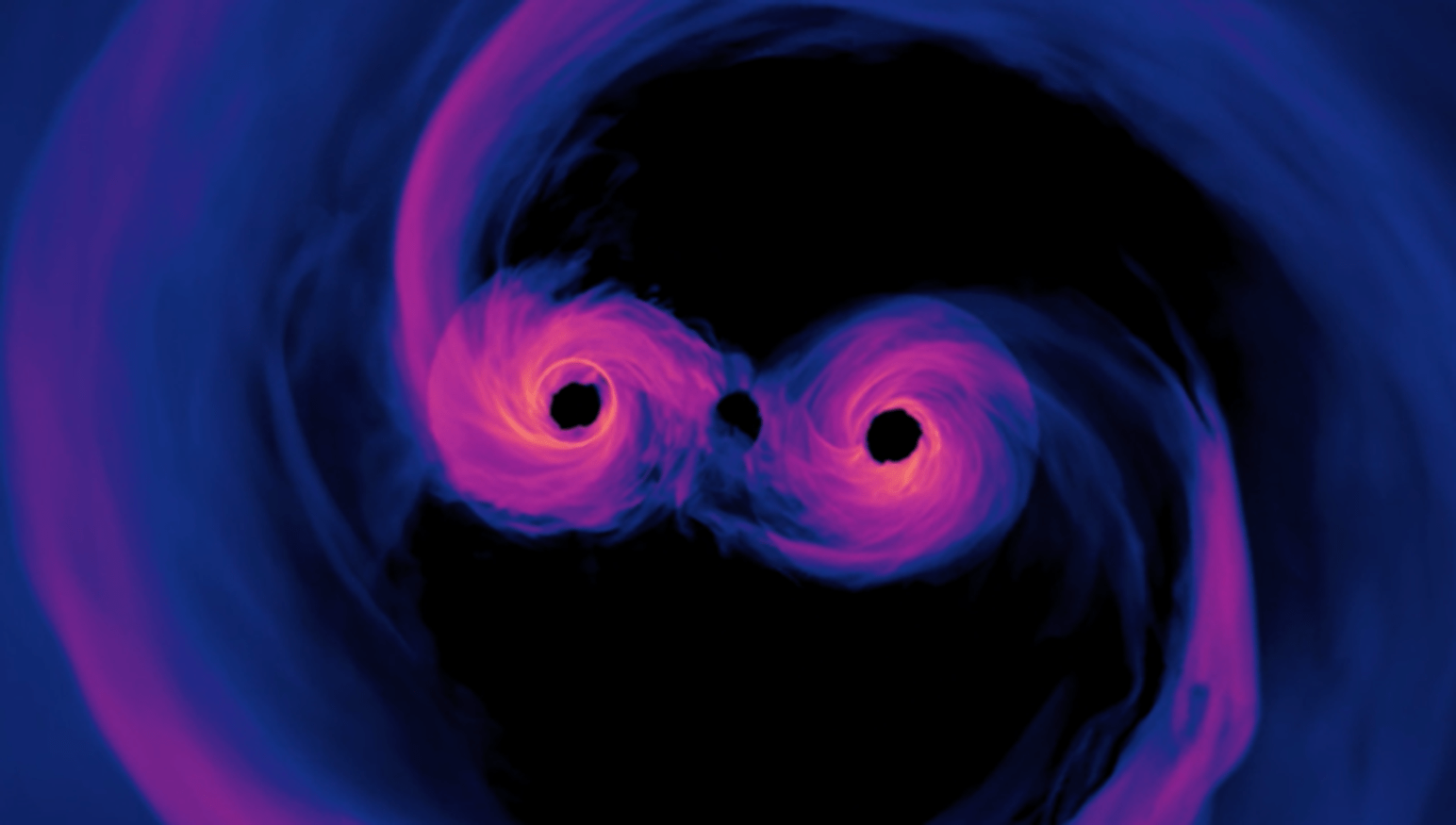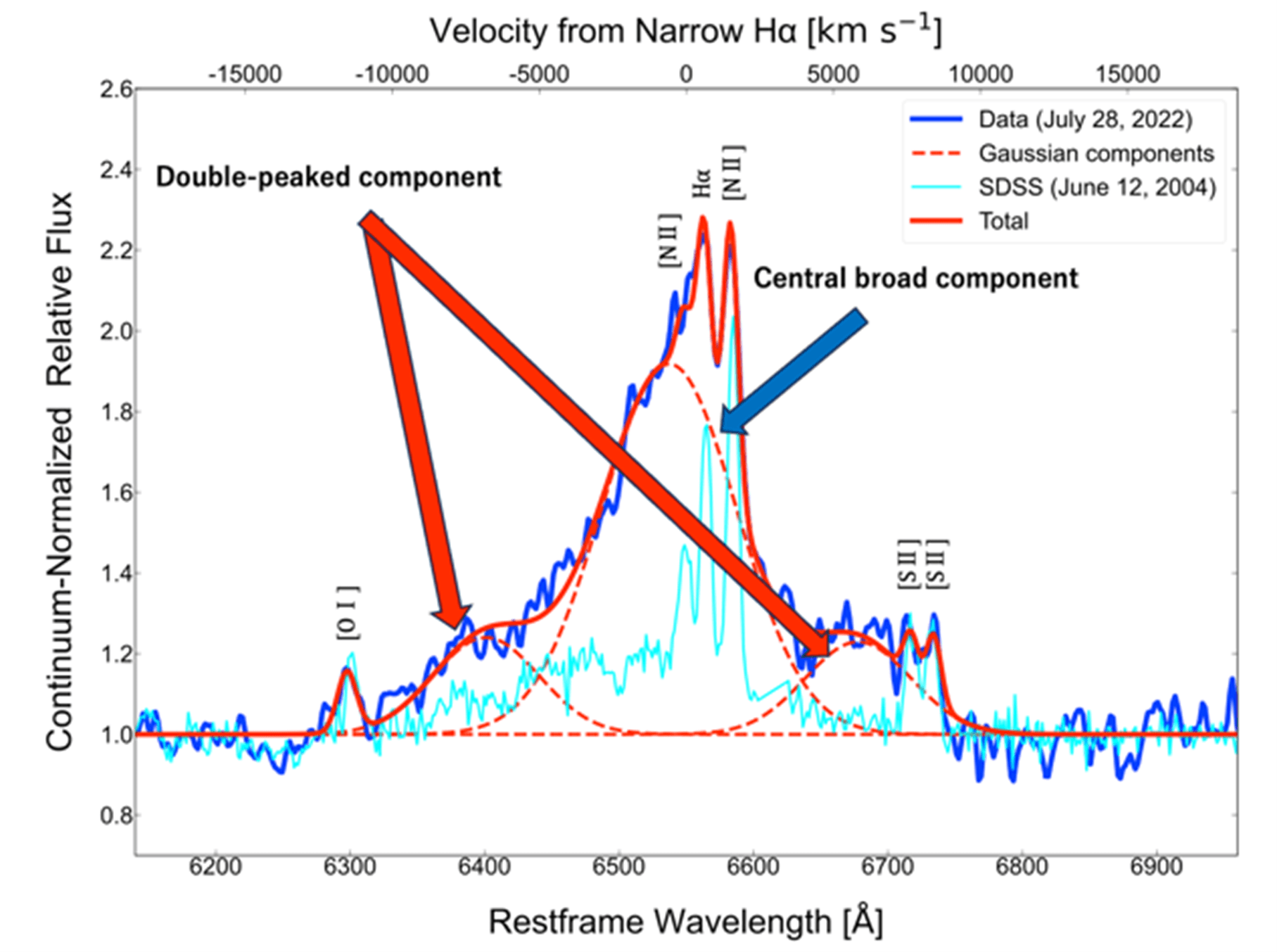The imminent merger of two supermassive black holes !?: Origin of the complicated broad line profile
Jun. 14, 2024 | GATEWAY to Academic Articles
It is widely accepted that supermassive black holes (SMBHs) *1 with masses exceeding a million times that of the Sun are located at the centers of many galaxies. When two galaxies merge, their central SMBHs are brought together, forming an SMBH binary. However, as the two SMBHs approach each other and the distance between them reduces to about a parsec (approximately 3.26 light-years), the black holes need to lose energy to continue their inward spiral and eventually merge through gravitational wave*2 emission. While the exact timescale for SMBH mergers in a few parsecs is still an open question, it is considered to be on the order of millions of years or more, known as the "final parsec problem."
The Seyfert 1 galaxy*3 we observed, SDSS J1430+2303, is a unique object with the potential for two SMBHs to merge within three years. It is interesting to note that the optical broad emission line profile of this object also dramatically changes to a complex profile, not previously seen in a typical Seyfert galaxy, from 2005 to 2022. In this study, we conducted follow-up spectroscopic observations of SDSS J1430+2303 with the Seimei Telescope in May, June, and July 2022, and April 2023, to unveil the origins of the complex broad emission line in the Hα*4 region (6300-6800 Å).
Research Summary
The impact of two SMBHs orbiting each other on their surroundings has been widely discussed through theories and simulations (Figure 1). The target of our observation, the Seyfert 1 galaxy SDSS J1430+2303, is observed to produce very bright continuum*5 due to the accretion*6 of a large amount of material onto the SMBH at its center. This continuum illuminates atoms, molecules, and ions, causing them to emit emission lines from different regions. One of the potential signs of SMBHs forming a binary is quasi-periodic luminosity variations. These variations occur because the amount of material accreted changes as the two SMBHs orbit each other, resulting in changes in the emitted light.

The observed decay in the luminosity variation period in SDSS J1430+2303 suggests that the SMBHs are on a binary orbit with a shortening period, indicating that they could merge within a few years. Spectra of the Hα region taken by SDSS in 2004 showed typical features of a Seyfert 1 galaxy, but recent spectra of the Hα emission lines have become remarkably complex, showing an unprecedentedly broad spectrum with a central broad component and a double-peaked component (Figure 2).

In this study, we conducted follow-up observations using Kyoto University's Seimei Telescope, which has the largest primary mirror in Japan at 3.8 meters, four times a year to unveil the origins of these complex Hα emission lines. To identify the regions emitting these complex Hα lines, we utilized the time lag of the variations in the continuum. Considering the speed of light (approximately 300,000 km/s), it is possible to estimate the approximate location of the emission source from the time lag between the variations of the emission lines and the continuum. As a result, the central broad component, which showed significant changes relative to the continuum, was found to be emitted from a region far from the continuum source. In contrast, the double-peaked component showed no significant changes over the observation period, indicating that it is emitted from the vicinity of the SMBH. Therefore, it was revealed that the central broad component is emitted from the same region as the broad emission lines observed in Seyfert 1 galaxies, and the double-peaked component likely originates from the accretion disk located closer to the SMBH than the central broad component. These findings are considered quite unique even among the Seyfert galaxies with the most prominent line profile variations. We think that it's important to monitor the phenomena over a sufficiently long time scale, whether or not it is directly related to the predicted SMBH binary coalescence itself.
Terminologies
- *1 A black hole is so dense that even light cannot escape from it. A SuperMassive Black Hole (SMBH), a type of black hole with a mass range of 106-109 solar masses, is known to be located at center of the most galaxies.
- *2 A gravitational wave is an invisible (yet incredibly fast) ripple in space. Gravitational waves travel at the speed of light (186,000 miles per second). These waves squeeze and stretch anything in their path as they pass by.
- *3 Seyfert galaxies have a bright compact nucleus and show the bright continuum and the many emission lines. Seyfert 1 galaxies show both broad and narrow emission lines. Seyfert 2 galaxies show only narrow emission lines.
- *4 Hα is emitted when an electron occurs transition between n=3 and n=2 energy level. The wavelength center is 656.3 nm.
- *5 The continuum provides the baseline for the overall spectrum of its object. In Seyfert galaxies, the continuum is constructed from the nucleus and host galaxy emission. We focus on the continuum from the nucleus because it shows luminosity variation. The continuum of the host galaxy shows no significant variation.
- *6 Accretion is a process by which matter falls onto a central objects, such as a star and black hole under the influence of gravity. When matter is drawn towards a massive object, it often forms an accretion disk and release an amount of energy.
Information
| Journal Title | Publications of the Astronomical Society of Japan |
|---|---|
| Full title of the paper | The variability of the broad line profiles of SDSS J1430+2303 |
| DOI | https://doi.org/10.1093/pasj/psad083 |
| Publish date | 12 January 2024 |
| Author(s) | Atsushi Hoshi, Toru Yamada, and Kouji Ohta |
| ISAS or JAXA member(s) among author(s) | HOSHI Atsushi (Astronomical Institute, Tohoku University and Department of Space Astronomy and Astrophysics, ISAS), YAMADA Toru (Department of Space Astronomy and Astrophysics, ISAS and Astronomical Institute, Tohoku University) |


 HOSHI Atsushi / Astronomical Institute, Tohoku University and
HOSHI Atsushi / Astronomical Institute, Tohoku University and